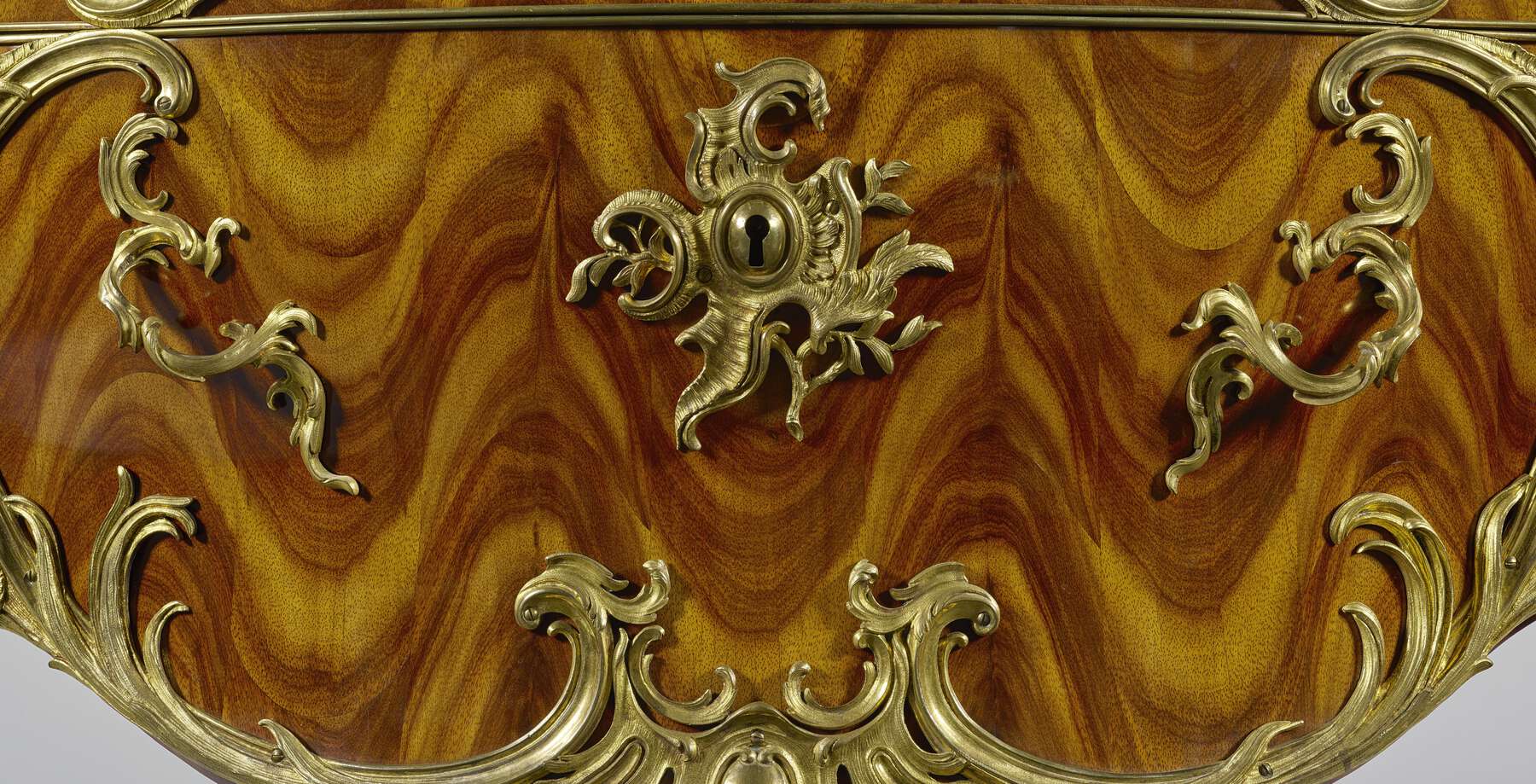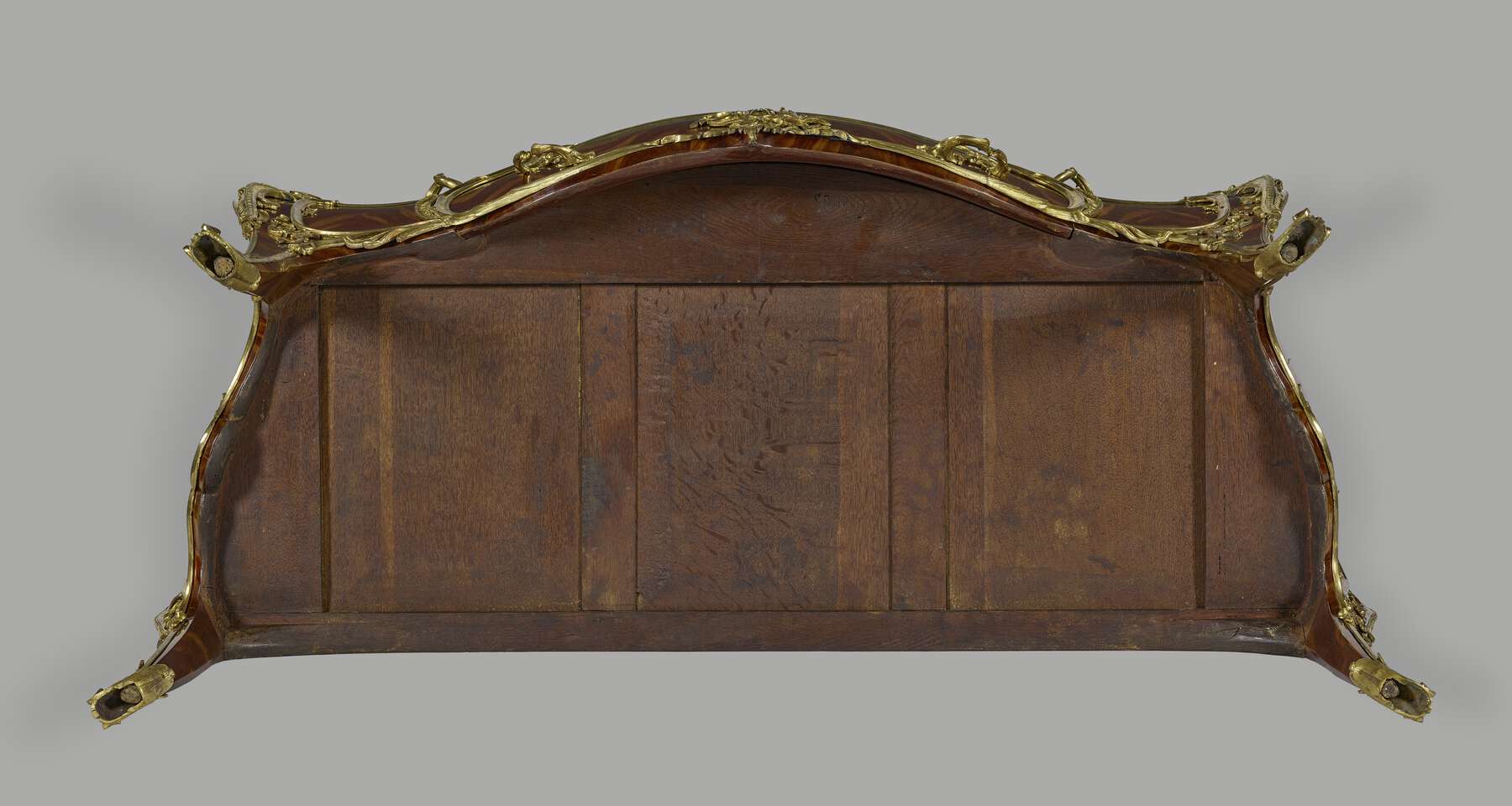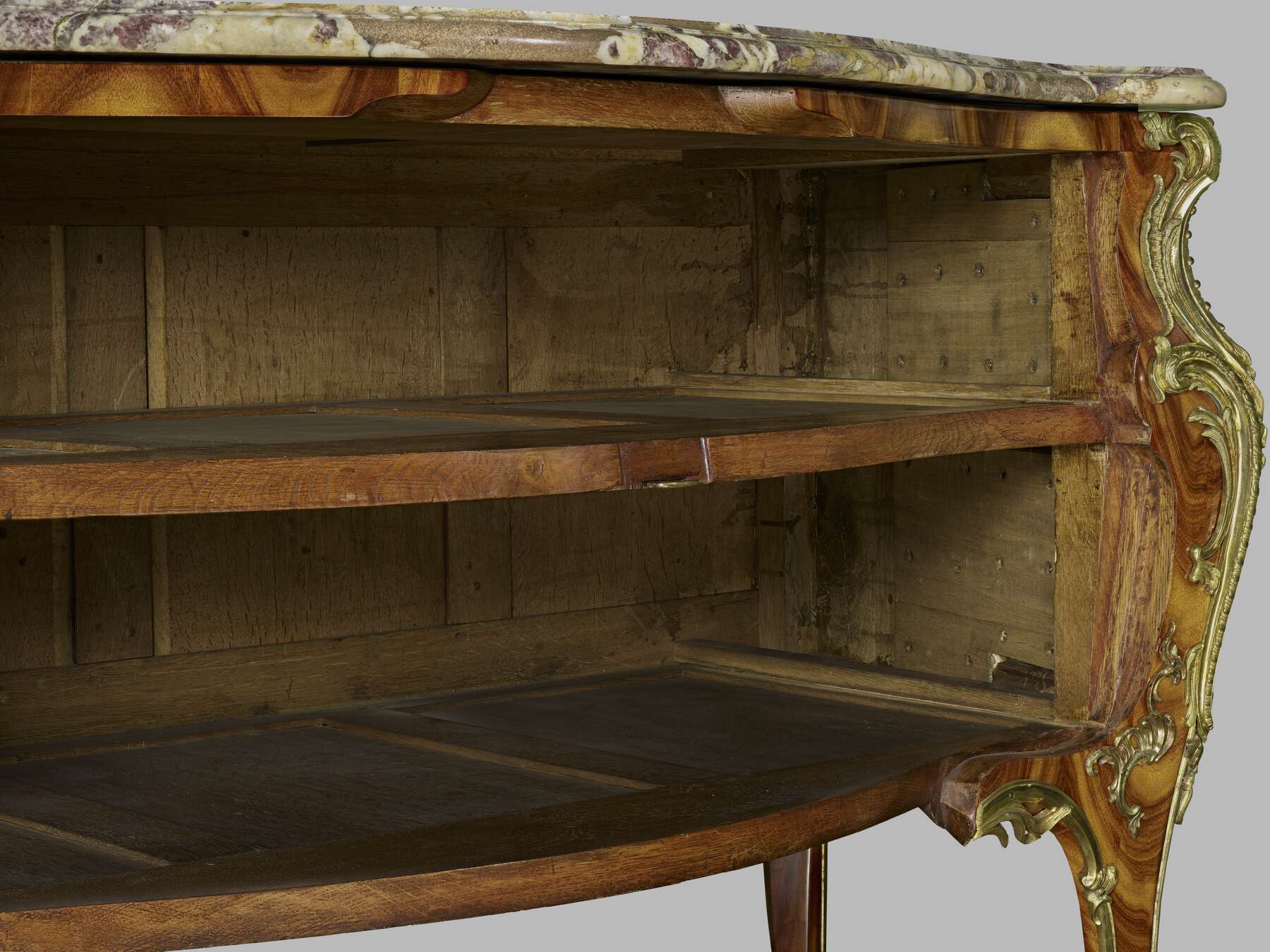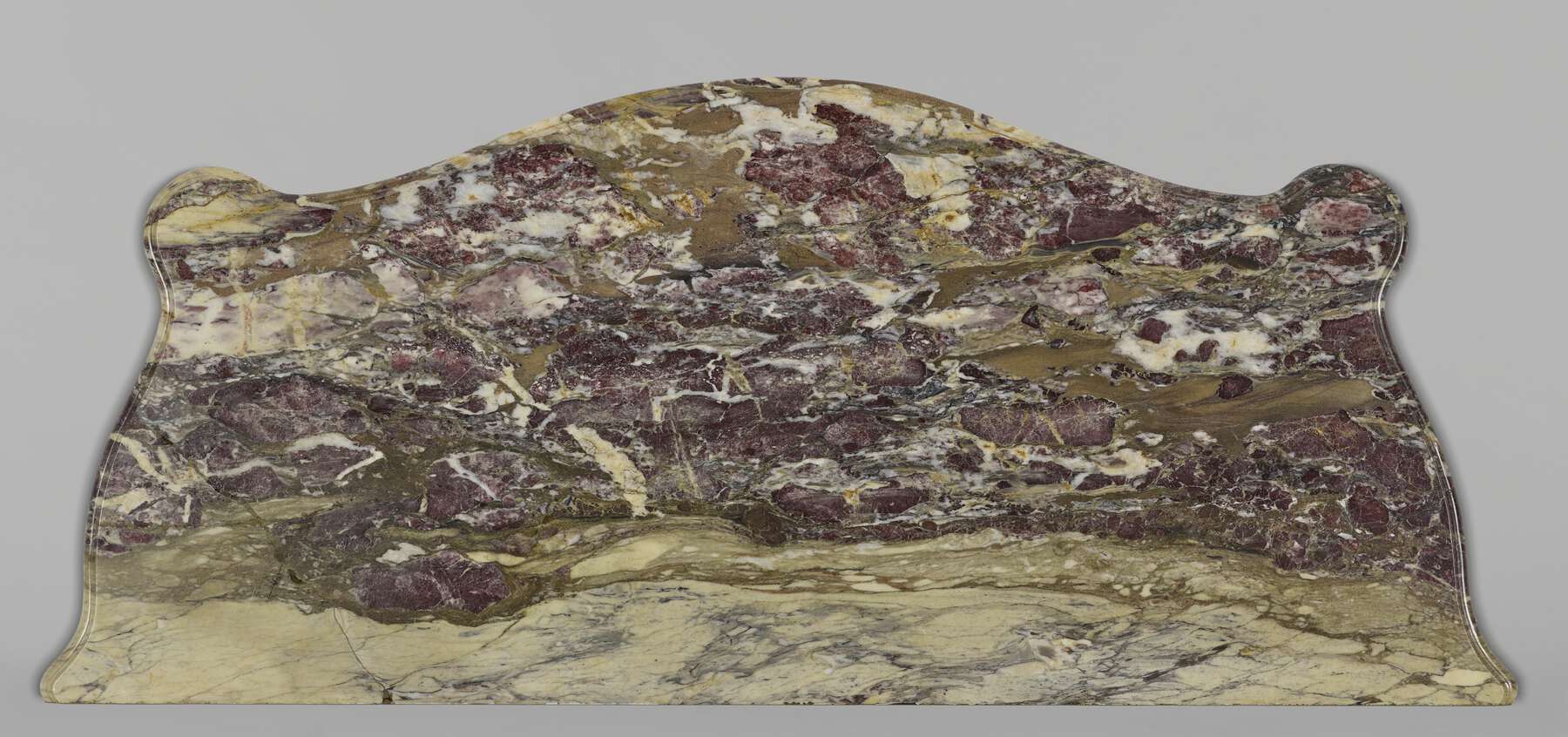16. Commode
- French (Paris), ca. 1750
- Attributed to Jean-Pierre Latz (French, ca. 1691–1754, ébéniste privilégié du Roi before May 1741)
- White oak* and poplar* veneered with bloodwood*; drawers of white oak and walnut*; brass and iron locks; gilt bronze mounts; fleur de pêcher marble top
- H: 2 ft. 10 1/2 in., W: 4 ft. 11 5/8 in., D: 2 ft. 2 5/8 in. (87.7 × 151.5 × 65 cm)
- 83.DA.356
Description
The rectangular commode, decorated with gilt bronze mounts, has bombé front and sides. It is supported on four cabriole legs of five-sided section. It contains two drawers, the face of the lower centered by a keyhole. The top is of fleur de pêcher marble shaped to conform to the top of the commode. It has a molded edge.
The front corners are set with mounts. Each is composed of a concave upper section that carries a descending row of bean-shaped godrons held by a burnished flat frame that extends above to leafy bifurcate scrolls and below in a short pendant of bell flowers and a bud. To either side of this arrangement are crimped ribbons.
The lower half the mount is of convex form. It is centered by a strip of small, concave bean-shaped cabochons interspersed with striations. The frame of the mount, set with egg and leaf molding, extends above it into a leafy scroll set with a small wing. A small pendant of three leaf buds is suspended from the end of the mount.
The foot mount takes the form of a bifurcated scroll framing a heavily stippled oval form containing an oval cabochon. A stud centers a bridge between the scrolls, and three short leaves curl below. The rest of the foot is composed of ribbed leaves and is topped at its center by a three-petal flower supporting a bud. A molded strip extends up the outer corner of the leg to the corner mount.
The front of the commode (fig. 16-1) is set with a large frame composed of C-scrolls, the four on the upper drawer set with a wing and strips of shellwork. On the lower drawer the frame is centered by a pierced symmetrical ornament composed of an ovoid figure flanked by abstract rocaille forms and foliate scrolls. The foliate elements continue to twist along the lower portion of the frame mount, almost reaching the front two legs. The lower drawer is also set with an asymmetrical keyhole escutcheon. Frilled shellwork and scrolls surround the oval keyhole. These asymmetrical features are set against a naturalistic twig whose leafy branches emerge from behind the rocaille ornament.
Marks
Stamped “RESTAURE par P. SPOHN” on the top of the carcass on the right back post (fig. 16-2).1
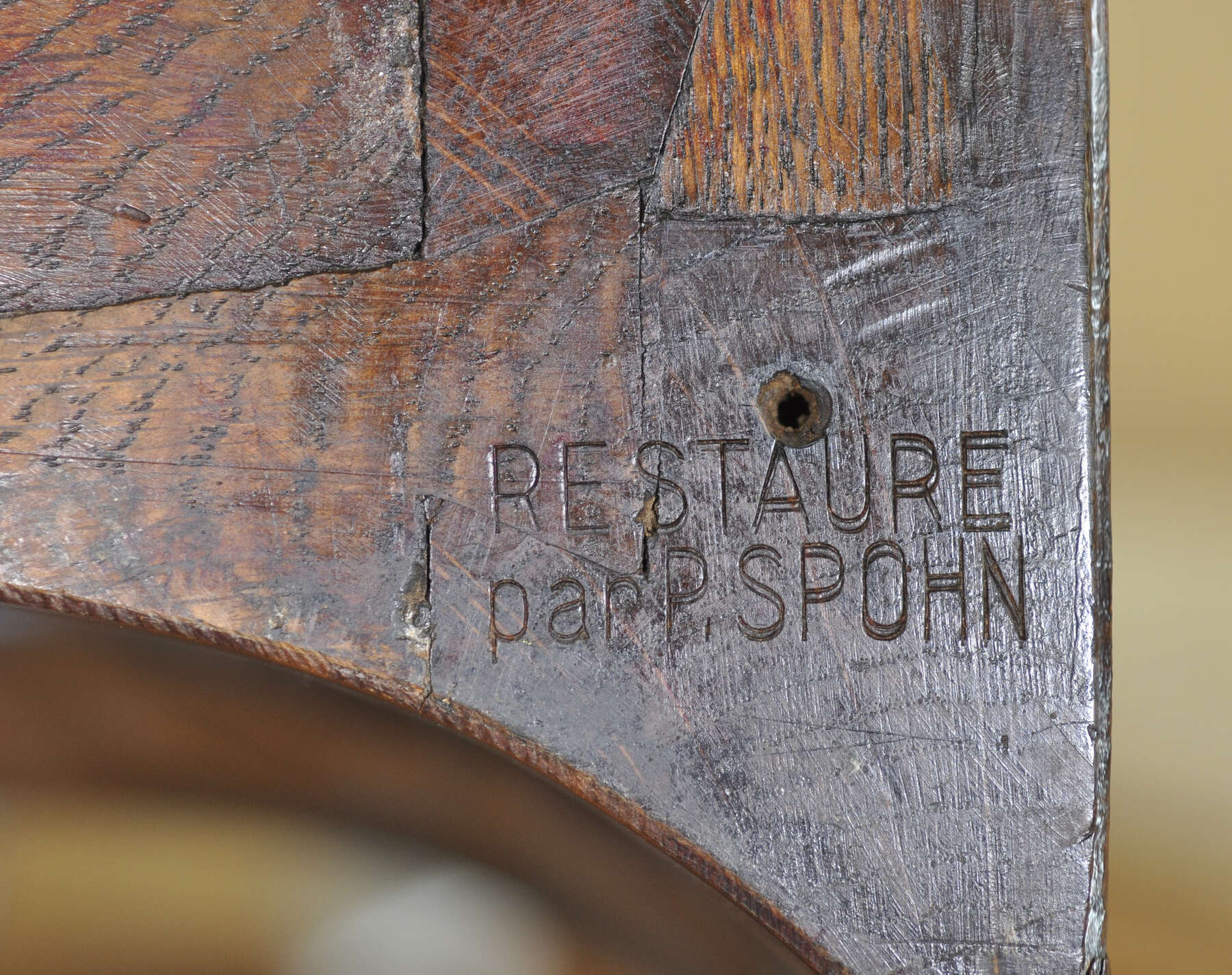 Figure 16-2
Figure 16-2Commentary
A commode of the same form, similarly mounted and veneered, and stamped “I.P.LATZ” is in the Palazzo del Quirinale in Rome (fig. 16-3).2 It was part of the large quantity of furnishings brought from France by Elisabeth of France to Italy after she became Duchess of Parma in 1748.3 That commode can be dated between 1745 and 1749 as its mounts bear the tax stamp of the crowned C.4 Styled Madame Infante after her marriage, the duchess made three voyages to Paris, in 1748, 1752, and 1759, with the evident aim of acquiring furnishings for the empty palaces of Parma.5 Included in these purchases were other pieces of furniture that are now attributed to Latz.6 The eighteenth-century provenance of the Museum’s commode is not known. It represents an instance where Latz has repeated a model for another patron. In any case, the Museum’s commode may postdate the one now in the Quirinale since the keyhole escutcheon has been cast without two small twigs to the left side that are found on the keyhole escutcheon on the other commode.7
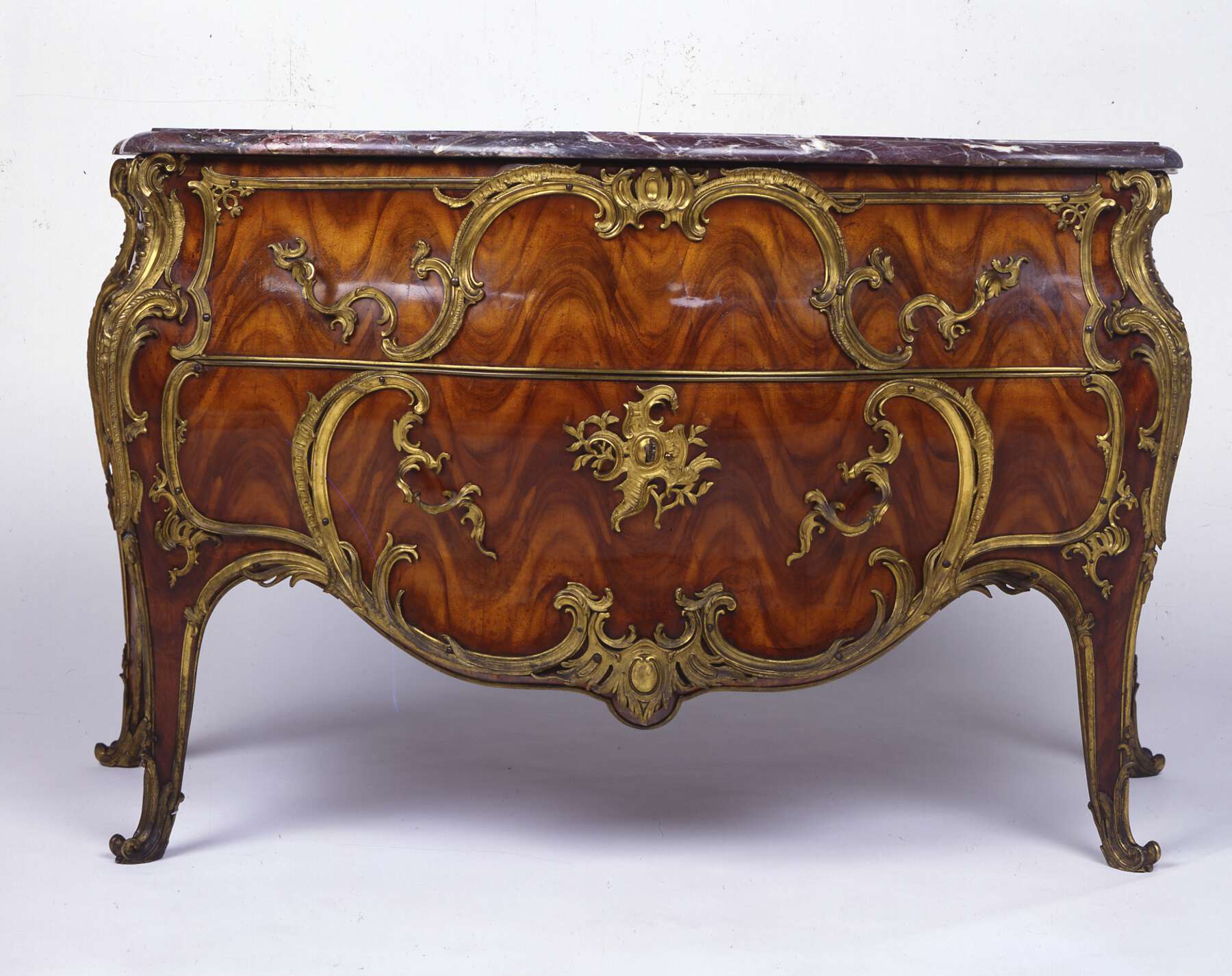 Figure 16-3
Figure 16-3This commode is characteristic of Latz’s documented works in form, decoration, and construction. Henry Hawley notes that furniture made by Latz is distinguished by being sculptural in form, usually with a rich surface decoration of marquetry and gilt bronze, and exhibits a tendency toward a dominant central field of decoration, clearly set off from the rest of the piece.8 The gilt bronze moldings that frame the drawers are not solely secured from the outside by screws or pins but are partially attached on the concealed sides of the drawers by means of metal flanges soldered to the reverse of the moldings, a feature characteristic of furniture made in the 1760s by Jean-François Oeben and Jean-Henri Riesener.
Hawley has demonstrated how the repetition of the mounts found on signed and unsigned pieces serves to confirm an attribution to Latz. In this respect, he regards the Quirinale commode as a keystone for the attribution of a large number of pieces to this maker. The relevance of the mounts in a discussion of the group of furniture listed above is that Latz held the exclusive rights to his models for gilt bronze mounts until 1749. He produced mounts in his own shop in violation of guild rules, and in 1749 various ornaments and tools were seized by guild authorities. He regained possession of his property, but after that date he relied on others to make the mounts using models that belonged to him. 9
In addition to the Museum’s commode, there are three other commodes, one stamped by and two attributed to Latz that have the same or similar mounts to those on the stamped Quirinale example. A stamped commode of the same form and carrying mounts of the same model (with the exception of the keyhole escutcheon) was sold at auction in 2006.10 It was veneered with end cut floral marquetry and featured a rather ill-conceived bird on the surface of the upper drawer, which may have been a later addition. An unstamped commode also in the Palazzo del Quirinale and attributed to Latz is of the same size and shape and for the most part has mounts of the same model as those on the Museum and stamped Quirinale commodes.11 It too is veneered with end cut floral marquetry. A commode in a private collection has many mounts of the same model.12 Only the chutes and drawer pulls are of a different model, and there is no escutcheon plate or mount at the junction of the legs and body. It is veneered with floral marquetry attributed to Jean-François Oeben and probably dates between 1750 and 1755.
Another series of pieces attributed to Latz have escutcheon mounts of the same model as on the unstamped Quirinale commode,13 and individual or groups of mounts on these pieces and on those listed above can be found on yet another group of pieces all consequently attributed to Latz.14 Thus the repetition of mounts on signed and unsigned pieces serves to confirm attributions to him that can also be made on the basis of the general style of the pieces and the designs and execution of their marquetry.
A small sketch in the Nationalmuseum, Stockholm, further strengthens the attribution of the Museum’s commode to Latz (fig. 16-4).15 The drawing in pen and ink on a single sheet shows a clock and a commode. This drawing is from a collection formed by the Swedish architect Carl Hårleman (1700–1753). He obtained it during a visit that he made to Paris in 1744–45. On the drawing, the design of the mounts of the Museum’s commode has been precisely, though incompletely, shown. The escutcheon plate is not represented in the drawing. The more fulsomely rendered drawing of the clock conforms to a clock acquired by Frederick the Great in 1746.16 Several of the mounts on this clock are also on the Cleveland Museum of Art’s clock (signed and dated 1744)17 and the stamped clock at Waddesdon Manor.18 Whether or not the drawing is by Latz, the design, we assume, is; therefore, it is probable that the design on which the Museum’s commode is based dates to the period 1744–45.
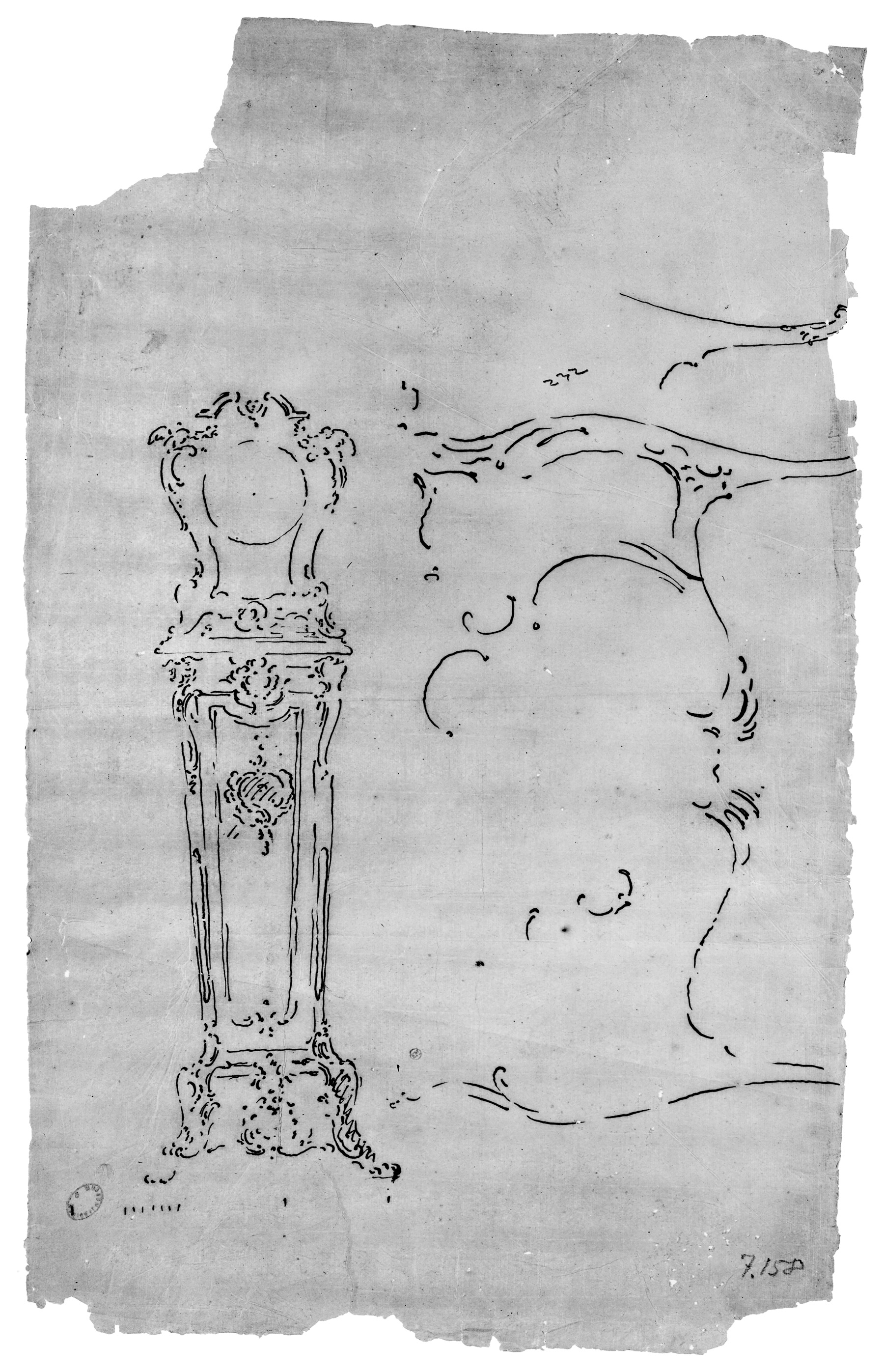 Figure 16-4
Figure 16-4The recognition in Latz’s work of a personal style presupposes his responsibility for the design of all furniture produced in his shop.19 Many drawings are listed in the inventories taken after his death in 1754 and the death of his wife in 1756.20 That these drawings were related to the cabinetmaker’s trade and were not merely in his private collection is indicated by their location (with the tools, etc.) and the low price gained for them, indicating that these drawings had little intrinsic value.21 It is evident that a single taste directed the production of the shop and that Latz designed the mounts used on his furniture.
Although an analysis and comparison of the mounts used on pieces by Latz is necessary for attribution, he was primarily a marquetry craftsman. It is the exceptional quality of the marquetry that distinguishes his work from that of his peers. Observation of Latz’s work indicates some variation in technical quality, particularly of his gilt bronze mounts. This is not surprising, though, since after the raid on his shop in 1749, he most likely relied on others to produce the mounts used on his furniture. However, the technical quality of his marquetry seems to have been consistently high. It varied in complexity from easily executed geometrical patterns to marquetry of brass and tortoiseshell, colored horn, and mother of pearl, of a sort that must have taxed the skills of any cabinetmaker to his limits.22
Characteristically, the marquetry on the Museum’s commode is of a superior quality. The strongly grained veneer forming a wave pattern on the commode is not commonly found. It was created by cutting a log of bois satiné obliquely to form oval veneers; these were then cut into rectilinear shapes and arranged to form waving lines. This is a particularly difficult type of marquetry to produce. Other pieces attributed to Latz with similarly arranged veneers are a pair of corner cupboards now in the Palazzo Pitti, Florence,23 and a bureau plat now in the Wallace Collection, London.24 The simple veneers of this bureau plat that make use of circular patterns of the wood grain resemble those of the Museum and the stamped Quirinale commodes. Other ébénistes also produced furniture with this type of marquetry; however, the wave-cut veneer on the pieces by Latz is in most cases more precise and extensive than that of other makers.25
Provenance
–1876: Anthony Nathan de Rothschild, first Bart., English, 1810–1876 (England), by inheritance to his daughter, Annie Henriette de Rothschild, 1876; 1876–1926: Annie Henriette de Rothschild, English, 1844–1926 (England), upon her death, held in trust by the estate, 1926; 1926–27: Estate of Annie Henriette de Rothschild, English, 1844–1926 [sold, Old French Furniture, Objects of Art, Porcelain and Tapestry, Christie’s, London, May 5, 1927, lot 138, for 980 guineas to S. Founés]; 1927– : S. Founés;26 Mme Duselschon (Château de Coudira, Prégny, Switzerland);27 Mme Rouvière (Lausanne, Switzerland);28 –1983: Maurice Segoura, Inc., founded 1957, dissolved 2006 (Paris, France), sold to the J. Paul Getty Museum, 1983.
Bibliography
, 197–98, no. 7, figs. 17a–b; , 160, fig. 136; , 26, no. 27; , 111; , 109, ill.; , 15, no. 27.
- G.W.
Technical Description
This remarkable commode exhibits a very high level of craftsmanship in its technically innovative marquetry, as well as in its exceptionally finely modeled and chased mounts. The four corner posts are made of single pieces of white oak, running from the floor to the top of the case. The case top is made as a tripartite frame-and-panel construction, with each of the framing rails attached to the corner posts using single, open-faced dovetails (fig. 16-5). Along their longer rear edges, the side rails are also attached to the rear rail with tongue-and-groove joints. The medial cross rails are both attached with double-pinned mortise-and-tenon joints. The left and center panels of the top are made of single panels of wood, while the third panel is made of two pieces glued together. The panels are chamfered on their interior faces, with a wide (~5 cm) plain chamfer. All of the panels of the commode are cut with this distinctive chamfer.
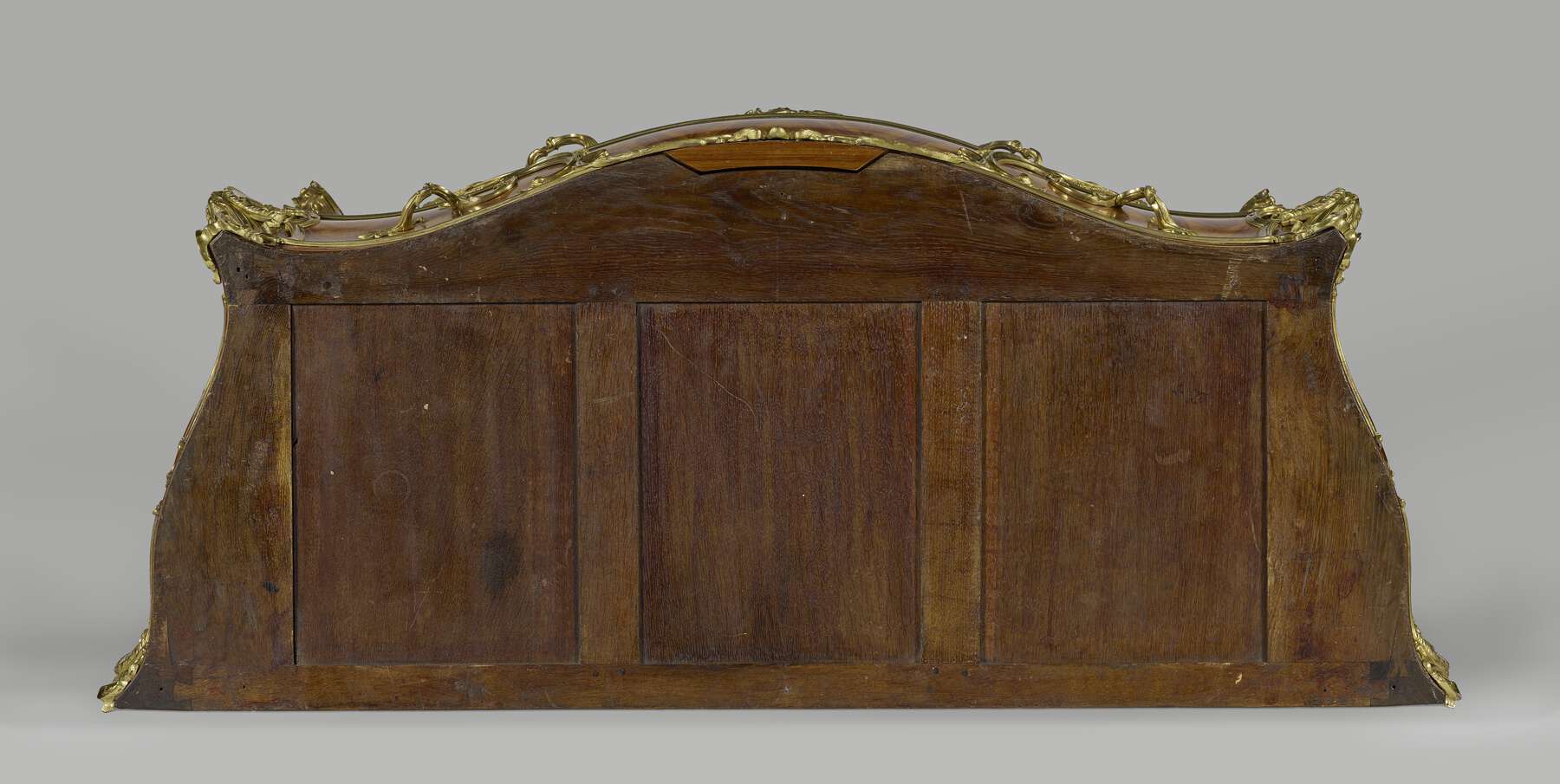 Figure 16-5
Figure 16-5The case bottom is also a tripartite frame-and-panel construction with dedicated rails around the entire perimeter that are not part of the construction of the sides or the back panel (fig. 16-6). The rear rail is attached to the corner posts with single-pinned mortise-and-tenon joints. The front rail is attached to the posts with horizontal sliding dovetails; the mortises of these dovetails do not traverse the entire post but are only cut into the rear two-thirds of the member, showing that the rail must have been slid into position from the back (interior). The side rails of the case bottom fit into dadoes in the corner posts at the front and rear. In addition, the longer rear edge of the rails attaches to the rear rail with a tongue-and-groove joint. The dustboard, which separates the two drawer compartments, is made in a fashion identical to the case bottom, except that the panels are all made of poplar. Each panel is made of one wide board glued to a narrower board. The right panel has on its underside a red chalk drawing of a male figure with a long queue, fencing. Portions of the drawing were cut away on all sides when the panel was chamfered (fig. 16-7).
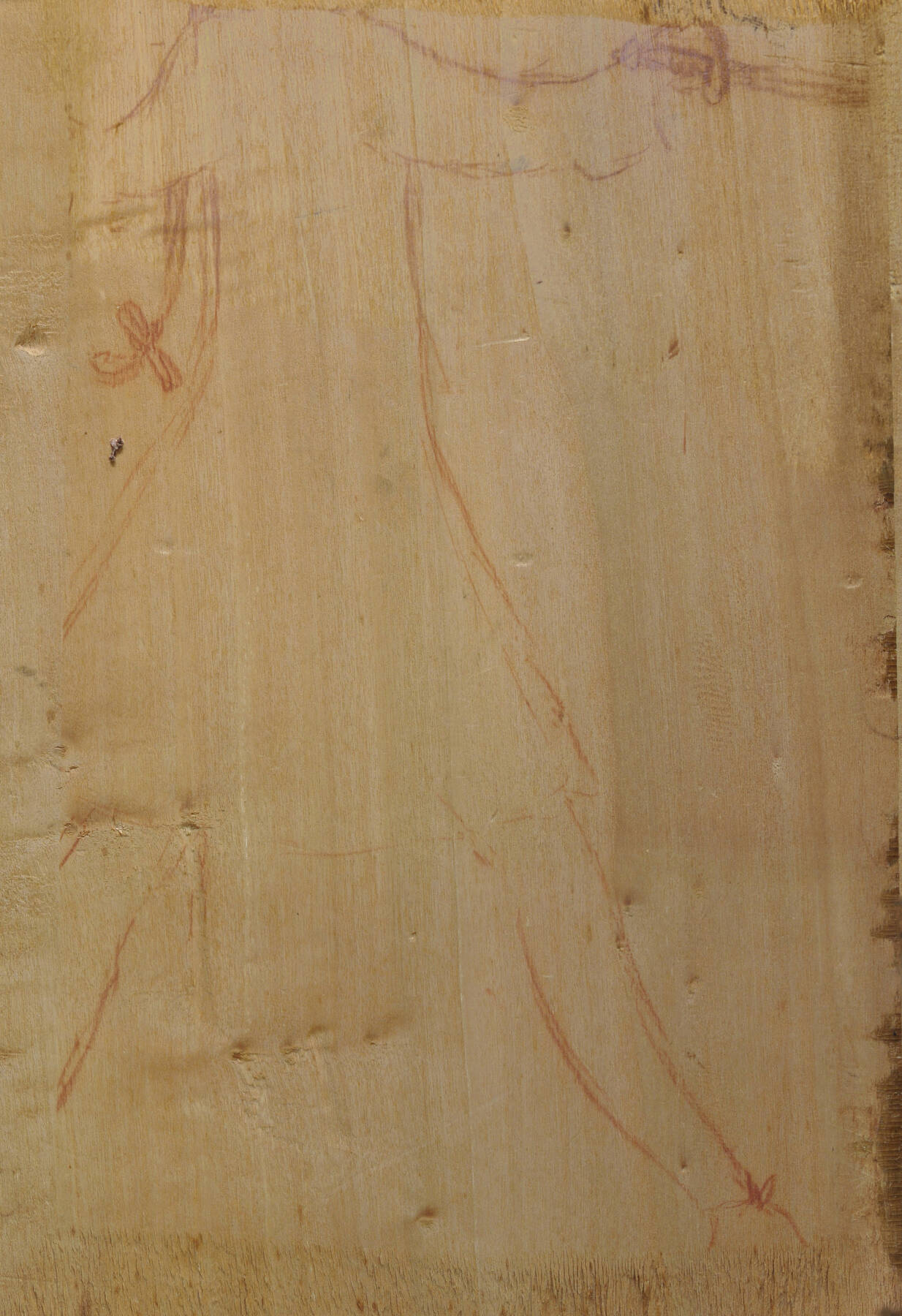 Figure 16-7
Figure 16-7The quadripartite case back is also made as an independent frame-and-panel construction, with its own dedicated top and bottom rails that are not part of the construction of the top or bottom panel assemblies. These bottom rails are mortise and tenoned into the end posts and are double pinned; the tenons are bare faced (flush on their interior faces). The vertical stiles are fixed into the top and bottom rails using the same joinery. All of the rails and stiles of the back are made of thinner stock than the case top and bottom assemblies; they are approximately 1.4 cm thick, while the others are approximately 2.1 cm thick. The panels of the back are each single pieces of wood, broadly chamfered on their inner faces. The rear rails of both the case top and the case bottom are attached to the horizontal rails of the case back with tongue-and-groove joints that run the full length of the pieces.
Each case side panel is made of three thick planks of oak, glued on edge and held with rabbet-and-dado joints along all four edges. The grain of these panels runs vertically.
The drawer fronts are made in a laminated construction with four tiers, stacked vertically. Each tier is either made of a single oak board or consists of three shorter boards, butted end to end. The drawer sides and backs are each made of a single board between 9 and 10 mm thick, with gently rounded top edges and dovetails, mitered at the top rear corners. The drawer bottoms are made of three butt-joined boards approximately 8 mm thick, with the grain running from side to side. Along their front edges, the bottoms fit into grooves in the drawer fronts. On the remaining three edges, however, the bottoms are simply screwed into the drawer sides from below with handmade tapered screws. Thin strips of oak, approximately 2.5 cm wide, are glued to the bottoms of the drawer along the side edges to serve as drawer runners. At each end of both drawer fronts, blocks of walnut with the grain running vertically are glued over the dovetails, creating a rounded extension of the drawer front beyond the drawer sides. The front corner posts of the case are carved back to receive these extensions when the drawer is closed. On the bottom drawer, the drawer extension is further elaborated with an additional layer of oak, with the grain running horizontally, glued to the face of the drawer front and overhanging the walnut block by an additional 1 to 2 cm. This construction creates an unusual two-stepped extension that produces the forward sweeping curve at the edges of the drawer front. To receive this extension when the lower drawer is closed, the corner posts on either side are carved back into a matching two-stepped recess, a very unusual feature (fig. 16-8).
The joinery of this commode is unique among the Museum’s Rococo collections because it makes use of four independent frame-and-panel constructions (for the top, back, bottom, and dustboard). It is more typical for the top, back, and bottom assemblies to share at least one rail between them so that, for instance, the rear rail of the top frame doubles as the top rail of the back frame-and-panel assembly or the bottom rail of the back frame doubles as the back rail of the bottom frame-and-panel assembly. It should also be noted that the joinery of this commode is entirely different than that of the Quirinale commode (see “Commentary” above). The Quirinale version, which is nearly identical to the Getty commode in its outward appearance, is built in plank construction (fig. 16-9). This is also highly unusual in this period, but interestingly it is similar in this respect to Latz’s corner cupboards described elsewhere in this volume (see cat. no. 17). It is possible that the apparent atypicality of Latz’s commode and cabinet joinery stems from the fact that the great majority of the production of his workshop was clock cases.29 The use of plank construction for long case clocks was quite common, so perhaps Latz’s familiarity with this construction method led his workshop to use it on larger case furniture where it was generally considered to be inappropriate. Wide boards are prone to expand and contract considerably across their widths with changes in relative humidity. The use of a frame-and-panel construction ensures that the overall dimension of the assembly (defined by the frame) remains constant even as the loosely fitted panel in the center is free to shrink and swell. The unusual aspects of the Museum’s commode’s frame-and-panel construction may also be attributable to the Latz workshop’s relative lack of familiarity with the construction of full-sized case furniture, or it might equally raise the possibility that the carcass construction was subcontracted to another cabinetmaking workshop.
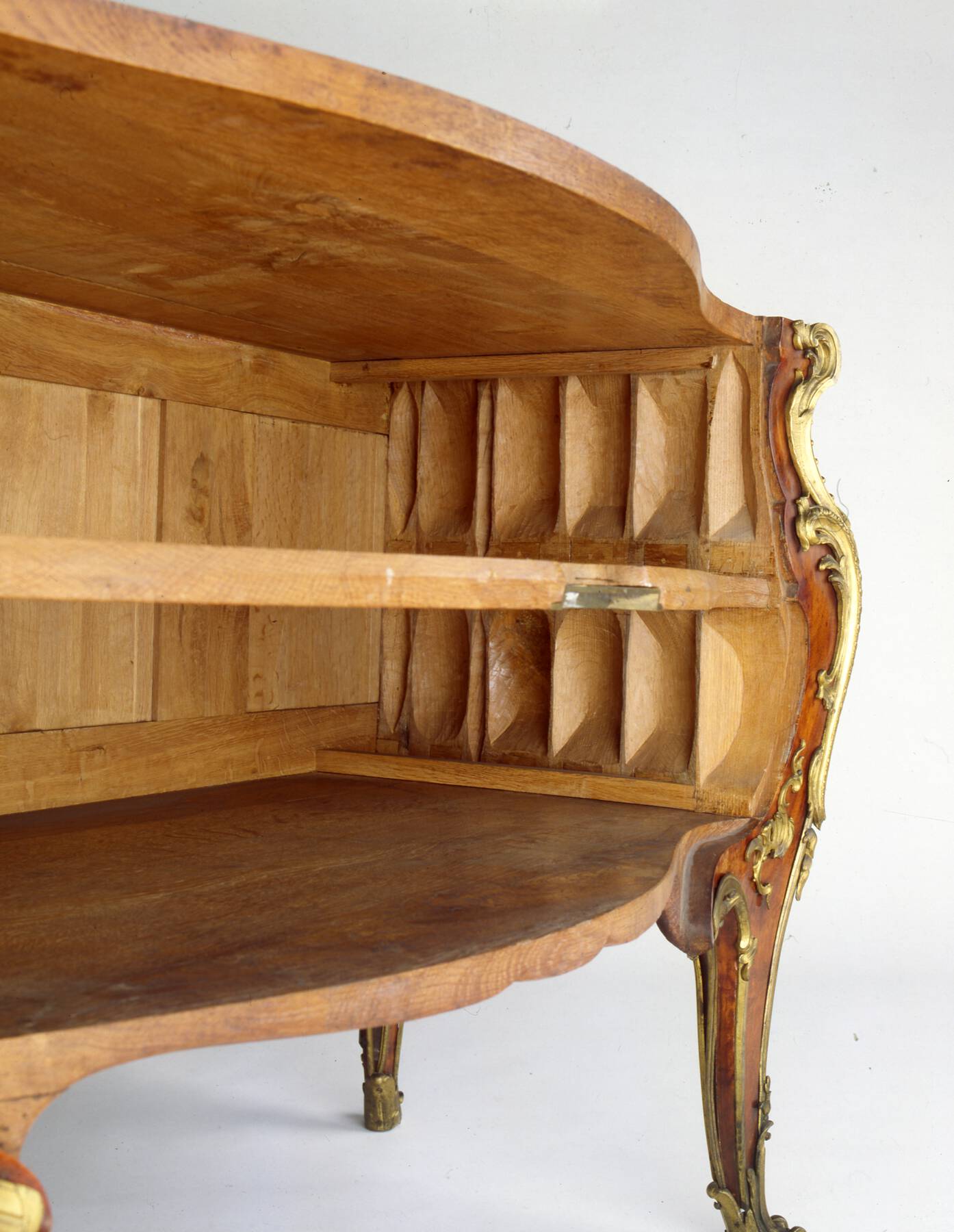 Figure 16-9
Figure 16-9The construction of the drawers of the commode is also atypical of most Parisian work from this period. Aside from the double-stepped extensions of the lower drawer front mentioned above, it is unusual in this period to find the drawer bottoms screwed to the lower edge of the drawer sides. Also unusual is the fact that the drawer bottoms are not housed in grooves or dadoes in the drawer sides but completely overlap both the sides and back. Although unexpected, there is no apparent indication that this construction is not original.
Many of the oak panels on this piece have significant sections (up to 2 cm wide) of light-colored sapwood in them. This includes two of the three panels comprising the top, two of the four back panels, and two of the three bottom panels. Sapwood is also found in the left side rail of the top, as well as in several of the laminated blocks in the drawer fronts. The sapwood of oak is much less resistant to insect infestation than the inner heartwood. Thus standard practice was to carefully cut away any remaining sapwood as larger boards were converted to pieces of furniture in the cabinetmaker’s workshop. The presence of significant amounts of sapwood within the carcass of this piece might be seen as a sign of the workshop’s taking shortcuts or lack of attention to detail. It may be worth noting that sapwood is also found in the Museum’s corner cupboards with cases attributed to Latz (see cat. no. 17).
Best practice of the day also dictated that knots of any significant size be cut away and discarded from the cabinetmaker’s wood before use, though this seems to have been less stringently observed than the proscription against sapwood. Still, the presence, in one of the vertical boards composing the right side panel, of a very large knot of nearly 15 cm in diameter must be considered extraordinary and confirms the sense that the workshop producing this commode’s carcass was less than meticulous in its wood selection.
Another unusual aspect of wood selection in the commode is the use of poplar for the panels of the dustboard. The use of poplar is extremely rare in Parisian ébénisterie. The only other confirmed examples in the Museum’s collections are in the serre-papiers by Bernard II van Risenburgh (cat. no. 3), where it was selected as a ground for the black European lacquer and for a small secret compartment panel in a cabinet by Benneman that dates to the 1780s (78.DA.361). Even in menuiserie, poplar is an unusual choice. In the Museum’s collection it has only been documented in a pair of globes, also decorated in European lacquer (86.DH.705). The fact that the most recent major restoration of the commode (presumably by P. Spohn; see below) utilized panels of poplar to reinforce the case sides suggests the possibility that the dustboard panels were replaced at this time, although conjuring a motive for replacing well-protected, interior panels such as these is rather difficult. In addition, careful examination reveals no evidence that the case of the commode has been dismantled to the extent necessary for the panels to have been replaced. It would appear that the originality of the poplar panels must remain unresolved for the moment.
At first, it seems worrisome that the transverse medial rails of the top, back, bottom, and dustboard are all exactly 2 1/2 in. (6.3 cm) in width, since imperial measurements were not used in eighteenth-century France. However, as no other members of the commode are consistently of imperial measure, it would appear that the rails were all cut from the same stock and that the measurement is merely a coincidence.
This commode is veneered in only one type of wood, identified microscopically as bloodwood. The wood is cut in the distinctive form of so-called sausage veneer. This type of veneer is obtained by sawing a log of wood at an oblique angle along its length, resulting in elongated oval pieces of veneer. By comparing the length to the width of the ovals it is possible to estimate that the log of bloodwood that produced the veneer was cut at an angle of about 25° off of the longitudinal axis.30 The striking composition of the marquetry was achieved by selecting the two arched sections of each oval and then placing alternating upward-facing and downward-facing arches next to each other in adjacent vertical bands.
Although the pattern of the undulating wood grain appears at first very simple and fluid, the cabinetmaker was obliged to construct a remarkably intricate patchwork of pieces to achieve this result, his work being greatly complicated by the complex curvature of the commode’s surfaces. Figure 16-10 illustrates the 135 individual pieces of veneer that were required to complete the composition just on the front of the piece. Aside from the challenge of choosing and arranging the pieces of veneer to form a smooth and unbroken pattern, the curvature of the substrate required that most of the larger pieces of veneer each be cut down into two or three smaller vertical sections (see dashed lines in fig. 16-10) and each resulting piece subtly reshaped so that they could be bent over convex or concave surfaces and still fit perfectly together at the edges. As an exaggerated example, one might imagine the way in which pieces of a map must be cut into lens-shaped sections so that they can be fitted onto a globe. The fitting of the veneer is flawless over the entire commode. Two points of technique help to explain how this was accomplished. First, the cabinetmaker divided the overall surface of the commode into smaller fields, defined by the applied gilded bronzes. He carefully matched the grain and fitted the veneer within each field but did not bother with careful fitting along the borders in areas that would be covered by the mounts. This suggests that the bronzes were fabricated and available to the cabinetmaker before the veneering was undertaken. Second, the ébéniste proceeded with his clamping and gluing of veneer one piece at a time. This is made clear by examination of X-radiographs in which the clear evidence of veneer pin holes can be observed. Adjacent to each individual piece of veneer, the faint impression of between one and three square holes in the substrate can be seen. When the cabinetmaker glued a piece of veneer in place, he would have hammered small veneer pins along its edge to prevent the piece from slipping out of place as he clamped it under a hot sandbag. Once the glue had dried, the clamp would have been removed and the pins pulled out. The next adjacent piece of veneer would then have been carefully fitted and glued next to the previous piece (covering the holes associated with the previous piece), and a new set of veneer pins would be hammered in along the leading edge. Thus the fact that each individual piece of veneer has pinholes next to it shows that each piece was glued and allowed to set before the next adjacent piece was applied. Furthermore, the placement of the veneer pins shows that the cabinetmaker began at the outside edges of each field and worked toward the center.
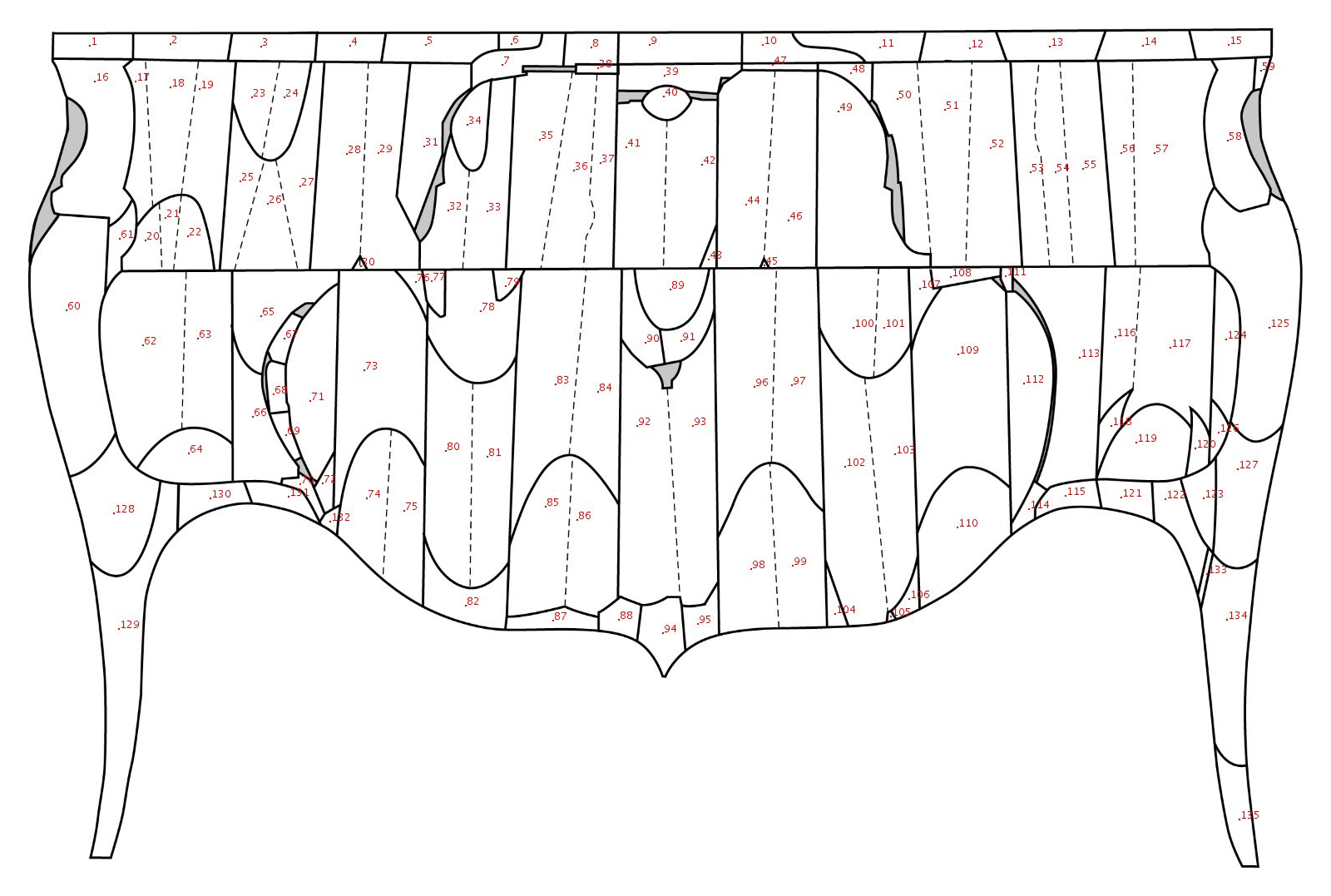 Figure 16-10
Figure 16-10On each of the other three commodes known today that have this veneer pattern (see “Commentary” above), the veneer is assembled in a slightly different way. That of the Museum’s commode is the only one to be arranged in regular vertical bands, while the others make use of more irregular shapes based on trapezoids. The Museum’s commode and the Quirinale commode are the only two in which the same waving pattern is extended to the rails and legs; the rails and legs of the two other commodes are veneered with simple and straight-grained tulipwood set at a 45° angle.
The gilded bronze mounts are of very high technical quality. The contrast between matted and burnished areas is pronounced, and the transitions are carefully delineated. The chasing of the matted areas shows a variety of textures and patterns, especially on the central escutcheon, where each element of the composition (e.g., leaves, wood, and feathers) is given its own distinctive and realistic texture. The burnished passages on the mounts are quite extensive and carefully executed. The mounts are also carefully fitted to the case, and the joints between elements are neatly hidden through precise filing and fitting. The mounts are all fastened to the case with screws. As in most cases in the Museum’s collection, the original fasteners have all been replaced over the years with modern screws. In addition to the screws, the drawer handles have been drilled and tapped on their rear surfaces to accept handmade threaded bolts, inserted from the rear through holes in the drawer fronts. The bolts were presumably added for extra strength.
The single lock in the lower drawer serves to secure both drawers. It has a double-throw bolt that passes upward through a pierced brass lock plate that is attached to the underside of the dustboard (securing the lower drawer) and then up into a separate brass lock plate fixed to the bottom edge of the upper drawer front (securing the upper drawer).
The mounts are generally in good condition, though there has been noticeable wear to the mercury gilding on protruding surfaces (the presence of mercury in the gilding was confirmed by X-ray fluorescence spectroscopy [XRF]). There is also some patchy coppery-orange-colored staining on many of the gilded bronze elements. Analysis of the spots by XRF confirms that the stains are enriched in copper. The cause of the stains is unknown, but they may result from a previous acid-based cleaning campaign.
Fourteen mounts were removed and analyzed by XRF to determine their alloy composition. The measured compositions were all found to be normal for mid-eighteenth-century casting brass, with about 18–24% zinc, about 1% each of tin and lead, and traces of many impurities such as silver, antimony, iron, and arsenic. Sections of the framing mounts on the drawer fronts and case sides have been soldered together, apparently with high-quality “spelter” brass, which has very high zinc content, around 35%. These results confirm that the mounts are very likely to be original to the commode.
The marble of the top is called fleur de pêcher (peach flower) (fig. 16.11). It is described by Margolis as “an intensely variagated breccia marble.”31 The fragments are violet, flesh-colored, tan, and gray-purple, embedded in a white matrix. This matrix is also fractured and is now held together by a dark purple cement. Veins and fractures are tinged with blue, green, and gold flecks. According to modern manufacturers of marble products, there are two fior di pesco varieties from Italy: carnico, which is flesh colored and relatively homogeneous; and classico, which contains red, flesh color, white, and blue, in a heterogeneous mixture. The rear portion of the top could possibly be described as carnico; however, the overall area is much more vividly colored.
The origin of the “flowers” in this marble is described by Dubarry de Lassale as possibly derived from stromatolites (structures created by algae in certain shallow warm-water marine environments).32 In the trade, fleur de pêcher, or fior di pesco, is often referred to as marmor calcidicum. Lazzarini and Borghini describe the source as Eretria, Calcide, Greece.33 However, Dubarry de Lassale (and modern manufacturers) state the source of fior di pesco is Serravezza, Carrara Basin, Italy, from a quarry opened in the seventeenth century. The tabletop is 3 cm thick. There is an old, repaired fracture in the right rear quadrant.
Although the overall condition of the marquetry decoration is extremely good, with no obvious replacement of veneer, there appear to have been at least two campaigns of significant structural restoration of the commode. The first appears to have involved the removal of the left and right panels of the case back assembly. Thin strips of the framing members surrounding the panels were carefully cut away on the rear side, exposing the groove and allowing the panels to be removed without dismantling the pinned mortise-and-tenon joints of the frames. Subsequently, the original panels appear to have been placed back into their frames and the strips of oak carefully glued and nailed back in place. The nail heads were covered over and disguised so that the traces of this intervention are now nearly invisible to the naked eye, though the nails are easily located with a magnet and all of the cuts in the frames are readily apparent in X-radiographs. It is not entirely evident why this was done. Removal of the two panels would not appear to have facilitated any further dismantling of the structure. One possible explanation is that the panels were removed in order to allow easier clamping of loose elements on the rear part of the case sides during the restoration. The fact that apparently modern wire nails were used to reattach the cut-away strips of oak to the frames (visible in X-radiographs) suggests that this intervention took place after about 1880, when the use of industrially produced wire nails became widespread, though it must be considered that handmade wire nails were available in the mid-eighteenth century.34
A second and more substantial restoration appears to have taken place sometime in the mid-twentieth century, probably while the commode was in Switzerland. The supposition that the restoration occurred in Switzerland is based simply on the observation that the commode has a twentieth-century history only in England, Switzerland, and the United States; since the restorer’s stamp is in French (see below), it would appear most likely that the restoration occurred in Switzerland. During this restoration, major splits in the case sides and drawer fronts were repaired and the bottom of the upper drawer was planed down and reattached to the sides with replacement screws. On the right side of the commode, the oak substrate panel had a single massive split, revealing a gap of approximately 1 cm. The restorer (presumably the enigmatic P. Spohn who stamped the commode on the top of the right rear post “RESTAURE par P.SPOHN”; see fig. 16-2) addressed this large split with a creative, if heavy-handed approach. Rather than fill the split, which would require extensive veneer patching or inpainting, he improvised a method of pushing the side panel back together. The problem the restorer faced was that the panel remained securely attached to both the front and rear posts; this he solved by sawing the front half of the panel free. First, he removed the gilded bronze frame from the side, and then, starting at either the top or bottom of the split, he sawed straight through the case, following the contour of the gilded bronze so that his saw kerf would be hidden once the mounts were replaced (fig. 16-12).
As the restorer came to the vertical portion of his line, parallel to the front of the commode, his cut ran into the rear edge of the front post. He did not stop, however, but continued to cut through the post in order to free the front section of the panel. Once the panel section was free, the restorer slid it toward the back, closing and gluing the split in the case side but also opening a new gap along the vertical saw kerf. The restorer then filled this new gap with glue and oak wedges driven into the gap from the outside (fig. 16.13). The tapered ends of the wedges were not cut off and are still visible inside the case.
 Figure 16-12
Figure 16-12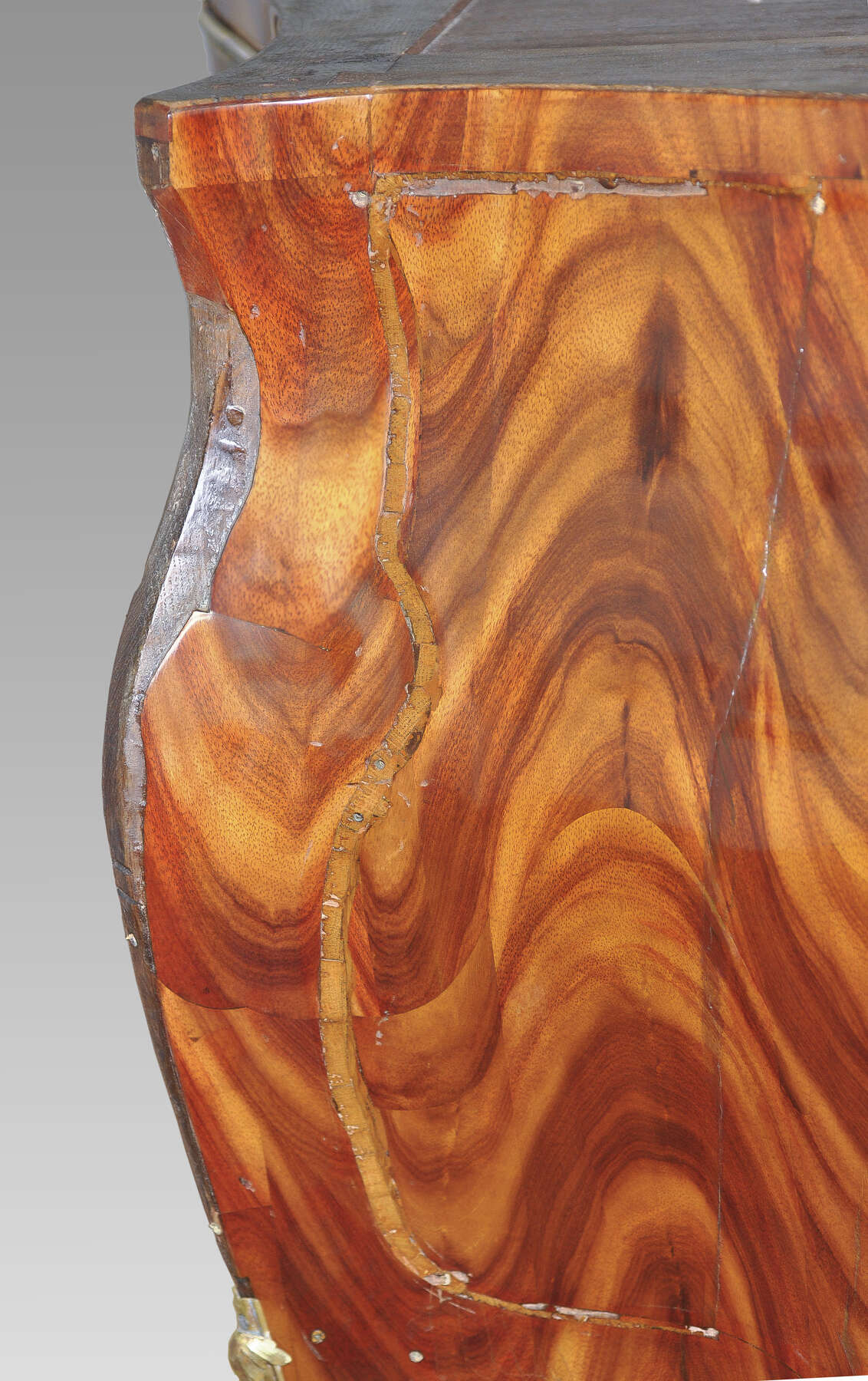 Figure 16-13
Figure 16-13In an attempt to further stabilize the case side, the restorer then cut two planks of poplar, which fit against the inside face of the side panel, inside the top and bottom drawer compartments. These reinforcing panels run nearly the full width of the case side, with their grain running horizontally, that is, perpendicular to the case side panel. He then glued and screwed the planks to the side panel, using an abundance of screws (average 12 per plank). On the left side of the commode, the side panel also suffered from splitting; rather than one major split, however, the panel had six smaller splits. Just as on the right side, the restorer screwed and glued horizontal poplar planks to the inside of the case side (see fig. 16-8). He then filled and inpainted the splits to match the surrounding veneer.
It appears that Spohn also repaired a loose joint between the right case side panel and the right rear post. Rather than simply rely on glue to repair the fault, he went so far as to drill five 9 mm holes in a vertical row, through the back of the post and well into the case side panel. X-radiographs suggest that Spohn used a screw-lead auger bit. He then drove 15-cm-long oak pegs into the holes to secure the joint (fig. 16-14).
 Figure 16-14
Figure 16-14The upper drawer front also has a split that has been repaired. The split runs horizontally through the central portion of the drawer front, and, like the case sides, it has been repaired in a rather heavy-handed manner. Five blocks of oak, each about 8 x 4 x 2 cm, have been inlaid into the rear side of the drawer front, separated by 3–4 cm and traversing the split (fig. 16-15). In addition, it would appear that at some point the glue joints of the upper drawer bottom failed and that possibly one or more of the boards warped or bowed to some degree. The drawer bottom has been reglued, and much of both surfaces has been planed down and flattened, removing the oxidized surface and revealing lighter-colored wood below. The screws fastening the upper drawer bottom have been replaced with screws very similar in type to those used to attach the poplar reinforcing planks on the case sides, suggesting (though certainly not proving) that the work was done at the same time, by the same restorer, presumably P. Spohn.
- A.H.,
- Y.C.
- and R.S.
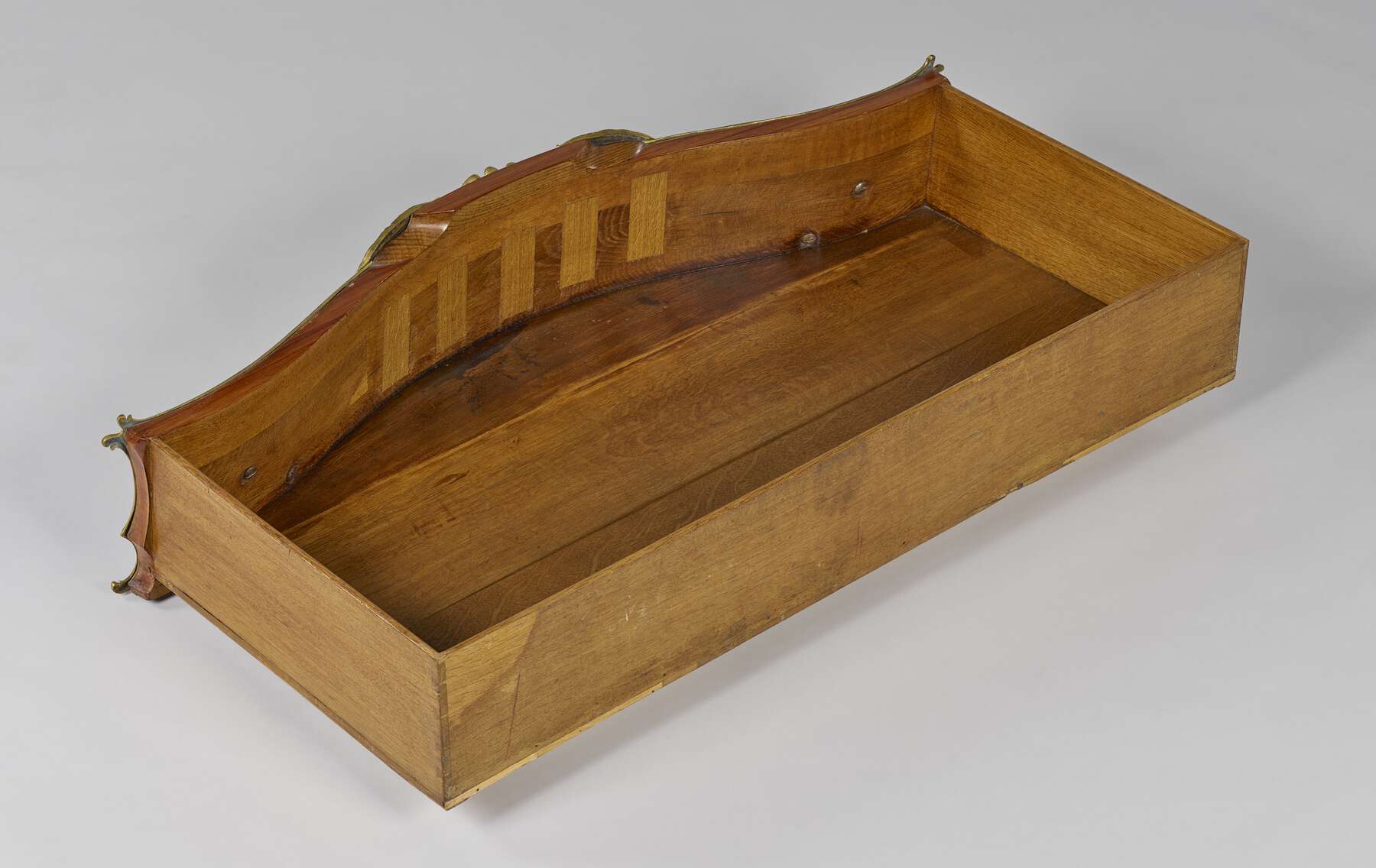 Figure 16-15
Figure 16-15Notes
There is no crowned C stamp on the commode, as mistakenly stated in the previous Museum’s catalogues (see “Bibliography”). ↩︎
See , 231–32, no. 21. All further references to works catalogued in this article will be referred to by the letter “H” followed by the catalogue number, e.g., (H21). See also , 108–11, no. 1. ↩︎
Louise-Elisabeth of France (eldest twin daughter of Louis XV), b. Versailles 1727, m. 1739 (to Philip, seventh son of Philip V, king of Spain, b. Madrid 1720, recognized as Duke of Parma by the treaty of Aix-la-Chapelle on October 18, 1748, and took possession of Parma in February 1749, d. Alessandria 1765), d. Versailles 1759. See . For a discussion of her continued taste for French furnishings and French influence on Parmesan furniture, see , 48–59. ↩︎
An edict of Louis XV, registered with Parliament on March 5, 1745, required that all works, old or new, made with copper either in pure form or as part of an alloy be stamped with a crowned C. This mark was canceled on February 4, 1749; therefore, objects with this stamp can be dated to between 1745 and 1749 . The commode also bears the royal household mark “CR” (Casa Reale) flanking a closed crown. The CR stamp was struck in about 1855 on most of the items and furniture at the ducal court in Parma. , 142. ↩︎
The three royal residences of Parma were the Palazzo Colorno, the summer residence; the Palazzo del Giardino, uninhabited at that time; and the Casa Reale, the ducal palace in Parma itself. They had been stripped of their contents by the outgoing regime. Louise-Elisabeth returned from her first trip, in 1749, with thirty-four wagonloads of furnishings; from her second trip, she returned in 1753 with fourteen wagonloads; she died at Versailles in 1759 before returning from her third trip home. All the furniture ordered in Paris between 1752 and 1754 was destined for the summer palace of Colorno. See , esp. 14–17, 48–50. See also , 132–35. ↩︎
A bureau plat, Palazzo del Quirinale (H34). Probably made between 1745 and 1749. It was brought by Louise-Elisabeth to Parma in 1753 and was to be found in her grand apartments at the Palazzo Colorno. See also , 128–33, no. 7.
A pair of corner cupboards, Palazzo del Quirinale (H46). Probably made about 1750. They were also part of the group of furniture brought by Louise-Elisabeth to Parma in 1753. See also , 122–25, no. 5.
A pair of corner cupboards, Palazzo del Quirinale (H47). Probably made about 1750, with the same history as those listed above. See also , 118–21, no. 4.
A pair of corner cupboards, Palazzo Pitti, Florence (see , 196, cat. no. 138, ill. on 197). These have bombé fronts and the same type of moiré marquetry as is found on the Museum’s and the stamped Quirinale commodes. Madame Infante also called on other Parisian craftsmen such as Jacques Caffieri, Jacques Dubois, Nicolas Quinibert Foliot, Jean-Baptiste Tilliard, and Bernard II van Risenburgh when choosing furnishings according to the latest Paris fashion. ↩︎
The commode in all the previous Getty Museum catalogues (see “Bibliography”) was dated ca. 1745–49 because of the incorrect assumption that it had a crowned C stamp on one of its mounts. ↩︎
, 207. ↩︎
, 153, 156. See also , 204–5 and Document 4, 211. ↩︎
Sold at Christie’s, Segoura, October 19, 2006 (New York: Christie’s), 2006, lot 100. The sale was of the remaining stock of the Parisian dealer Maurice Segoura. ↩︎
H28. See also , 112–14, no. 2. ↩︎
, 160–61, no. 43 (P. Leperlier); also , 160, fig. 135. ↩︎
These include the Pillnitz commode (H37), Moritzburg commode (H38), Woburn desk (H29), Ball desk (H31), and the commode sold at Christie’s, Segoura, October 19, 2006 (New York: Christie’s, 2006). See note 10 above. ↩︎
The most significant of these is the Waddesdon clock (H2) that is stamped “I.P.LATZ,” with crowned Cs, which imply a date between 1745 and 1749. The mount at the top of this clock seems very much related to the escutcheon plates discussed above. The surround of the pendulum window and the decorative motif immediately beneath it are to be found on both the Cleveland clock (H1, inscribed “LATZ A PARIS FECIT MDCCXLIV”) and the Museum’s planisphere clock (74.DB.2). Other pieces in this category include the Cleveland commode (H35), Toledo commode (H36), Waddesdon desk (H30), Edey clock (H4), and the Quirinale bureau plat (H34). ↩︎
See , 176, 179; Nationalmuseum, Stockholm, Sweden, acc. no. THC 7158. ↩︎
This clock (H12), in the collection of the Sanssouci Palace in Potsdam, is almost identical to one in Dresden from the Staatliche Kunstsammlungen (H11). Both clocks share the figure of Father Time from a clock formerly in a Parisian private collection (H3). ↩︎
H2. ↩︎
, 210. ↩︎
, 210 and Documents 5, 6, 7, all cited on p. 211. ↩︎
, 210. ↩︎
, 210. ↩︎
See citations in note 5 above; see also , 127, no. 312, illus. 128. ↩︎
See , vol. 2, 1050–54, cat. 207, acc. no. F112. ↩︎
For pieces by other ébénistes with similarly arranged veneers, see a bureau plat by Joseph Baumhauer at the Museum (cat. no. 15); a commode by Joseph Baumhauer in the Fine Art Museums of San Francisco, Legion of Honor (, 82); and a commode by Jacques Dubois at Waddesdon Manor (, vol. 1, 218–20, no. 47). The wave-cut pattern on the Latz pieces covers the entire surface, unlike the Baumhauer and Dubois commodes where it is restricted to the drawer fronts and side reserves. ↩︎
Receipt of sale in the files of the Sculpture and Decorative Arts Department, J. Paul Getty Museum. ↩︎
Correspondence with Maurice Segoura, November 9, 1983, in the files of the Sculpture and Decorative Arts Department, J. Paul Getty Museum. ↩︎
Correspondence with Maurice Segoura, November 9, 1983, in the files of the Sculpture and Decorative Arts Department, J. Paul Getty Museum. ↩︎
. ↩︎
The average height-to-width ratio of complete ovals matching the curvature of the veneer is about 2.25:1 based on five measurements. Therefore, if θ = the angle of the cut (off the vertical axis), then sinθ = 1⁄2.25 and θ = 26°. ↩︎
. ↩︎
. ↩︎
. ↩︎
. ↩︎
Bibliography
- 18th Century: Birth of Design 2014
- 18th Century: Birth of Design: Furniture Masterpieces 1650–1790. Exh. cat. Paris: Éditions Faton, 2014.
- Boutemy 1965
- Boutemy, André. “L’ébéniste Joseph Baumhauer.” Connaissance des Arts 157 (March 1965): 82–89.
- Bremer-David et al. 1993
- Bremer-David, Charissa, et al. Decorative Arts: An Illustrated Summary Catalogue of the Collections of the J. Paul Getty Museum. Malibu, CA: J. Paul Getty Museum, 1993.
- Briganti 1965
- Briganti, Chiara. “Comment Madame Infante a meublé sa résidence de Parme.” Connaissance des Arts 161 (July 1965): 48–59.
- Briganti 1969
- Briganti, Chiara. Curioso itinerario delle collezioni ducali parmensi. Parma: Cassa di Risparmio di Parma, 1969.
- Cirillo and Godi 1983
- Cirillo, Giuseppe, and Giovanni Godi. Il mobile a Parma fra barocco e romanticismo 1600–1860. Parma: Ermanno Albertelli Editore, 1983.
- Colle 1992
- Colle, Enrico. I mobili di Palazzo Pitti. Vol. 2, Il primo periodo lorenese 1737–1799. Florence: Centro Di, 1992.
- De Bellaigue 1974
- De Bellaigue, Geoffrey. The James A. de Rothschild Collection at Waddesdon Manor: Furniture, Clocks and Gilt Bronzes. 2 vols. Fribourg: Office du Livre, 1974.
- Dubarry de Lassale, Barco, and Bresc-Bautier 2000
- Dubarry de Lassale, Jacques, Sylvie Barco, and Geneviève Bresc-Bautier. Identifying Marble. Dourdan: H. Vial, 2000.
- González-Palacios 1996
- González-Palacios, Alvar. Il patrimonio artistico del Quirinale, gli arredi francesi. Milan: Electa, 1996.
- Hawley 1979
- Hawley, Henry. “A Reputation Revived.” The Connoisseur 202, no. 813 (November 1979): 176–82.
- Hawley 1970
- Hawley, Henry. “Jean-Pierre Latz, Cabinetmaker.” Bulletin of the Cleveland Museum of Art 57, no. 7 (September–October 1970): 203–59.
- Hughes 1996
- Hughes, Peter. The Wallace Collection Catalogue of Furniture. 2 vols. London: Trustees of the Wallace Collection: 1996.
- Lazzarini 2004
- Lazzarini, Lorenzo. Pietre e marmi antichi: Natura, caratterizzazione, origine, storia d’uso, diffusione, collezionismo. Padua: CEDAM, 2004.
- Margolis 1987
- Margolis, S. “Marbles in the J. Paul Getty Museum.” Los Angeles: J. Paul Getty Museum, 1987.
- Pallot 1989
- Pallot, Bill G. B. The Art of the Chair in Eighteenth-Century France. Paris: ACR-Gismondi Éditeurs, 1989.
- Pradère 1989a
- Pradère, Alexandre. French Furniture Makers: The Art of the Ébéniste from Louis XIV to the Revolution. Malibu, CA: J. Paul Getty Museum, 1989.
- Réaumur 1761
- Réaumur, René Antoine Ferchault. Art de l’épinglier, par M. de Réaumur, avec des additions de M. Duhamel Du Monceau, et des remarques extraites des mémoires de M. Perronet . . . Paris: Saillant et Nyon, 1761.
- Ramond 2000a
- Ramond, Pierre. Masterpieces of Marquetry. Vol. 2, From the Régence to the Present Day. Los Angeles: J. Paul Getty Museum, 2000. Originally published as Chefs-d’oeuvre des marqueteurs. Vol. 2, De la Régence à nos jours. Dourdan: Éditions H. Vial, 1996.
- Verlet 1937
- Verlet, Pierre. “A Note on the ‘Poinçon’ of the Crowned ‘C.’” Apollo 151 (July 1937): 22–23.
- Wilson, Sassoon, and Bremer-David 1984
- Wilson, Gillian, Adrian Sassoon, and Charissa Bremer-David. “Acquisitions Made by the Department of Decorative Arts in 1983.” J. Paul Getty Museum Journal 12 (1984): 173–224.
- Wilson and Hess 2001
- Wilson, Gillian, and Catherine Hess. Summary Catalogue of European Decorative Arts in the J. Paul Getty Museum. Los Angeles: J. Paul Getty Museum, 2001.
